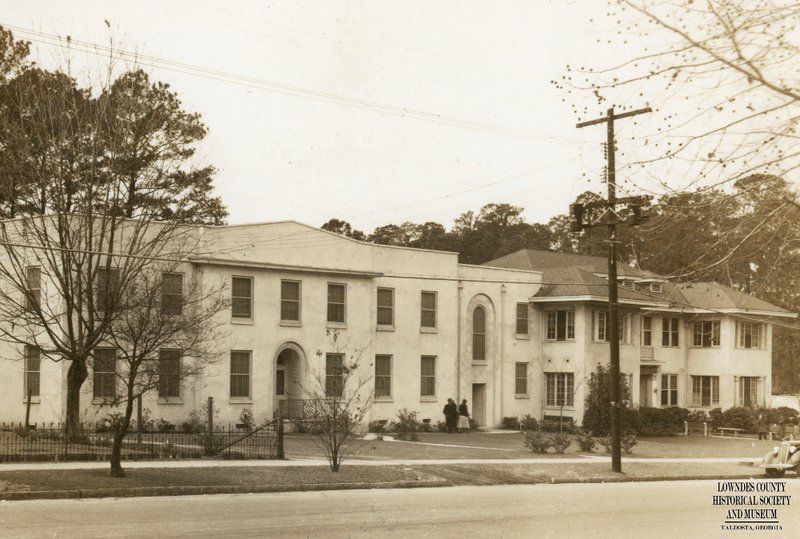Health care in Valdosta takes quantum leap from 1920s
Published 9:00 am Sunday, March 29, 2020

- Courtesy Lowndes-Valdosta Historical SocietyThe Little-Griffin-Owen-Saunders Hospital was founded in Valdosta in 1915.
VALDOSTA — From the pre-penicillin days of the 1920s to the modern era of heart surgery and telemedicine, Lowndes County has come a long way in the field of health care.
In the early part of the 20th century, there were few municipally-owned hospitals in America and none in Valdosta. The standard practice of the time was for individual doctors to run sickrooms or small hospitals as a part of their business; only patients of that particular doctor could use those facilities.
In 1915, Dr. A.G. Little and Dr. Archibald Griffin built a private hospital at 1307 North Patterson Street. It was named the Little-Griffin Hospital, and since it was a private facility, its use was limited to patients of the two physicians.
At first, Little-Griffin Hospital had 40 patient beds, an X-ray department, a laboratory, an emergency room, an operating room and a food services department, with a staff of two doctors and a dozen nurses.
In 1921, Dr. Frank Bird and Dr. J.F. Mixson opened an infirmary in the upper story of a building at the corner of Central Avenue and Ashley Street. Six years later, the Bird and Mixson Infirmary moved into a larger building intersecting Stevens and Briggs Streets with Central Avenue. In 1932, Mixson and Bird dissolved their partnership, but Bird continued running the hospital.
In 1943, Bird suffered major injuries when he fell down an open elevator shaft in his hospital; he was forced to close the facility as a result, according to a newsletter from the Lowndes-Valdosta Historical Society. The building was sold to the county government and housed the health department until 1959. The Bird Hospital building is now being remodeled into an adjunct for the historical society.
In Hahira, Dr. Raymond Smith founded Smith Hospital in 1943, and the red-brick facility served the town for more than half a century. New owners moved the hospital to a new building on North Valdosta Road in 2002 and renamed the facility Smith-Northview Hospital
Post-World War II growth brought the Little-Griffin Hospital — eventually known as Little-Griffin-Owen-Saunders Hospital — to a 105-bed facility with a school of nursing and a number of specialist doctors allowed to practice there.
However, a push was on for a publicly-owned hospital in Valdosta, and in 1948 the city and county formed the Lowndes-Valdosta Hospital Authority. A new federal law provided funds alongside state and local money to build municipal hospitals.
In 1950, Lowndes voters approved the use of county funds in a public hospital project. A site was selected, and work began on the new Pineview General Hospital.
State law required that, in order to get government money to build a public hospital, the owners of all local private hospitals had to agree to close up shop. On July 1, 1955, the day the 100-bed Pineview opened, 35 patients were transferred from Little-Griffin, which closed its doors for good.
Pineview General expanded over the years, becoming a regional healthcare center, which was reflected in the new name the hospital adopted in 1971 — South Georgia Medical Center.
In 1972, Lowndes County became one of the first districts in the country to have an ambulance service with trained medics and ambulances with advanced life-support equipment and radio telemetry. Before then, it was common practice for funeral home hearses to carry emergency patients to hospitals.
SGMC now serves a wide range of the area’s medical needs; expansions have included a cancer center, the Dasher Heart Center, a helipad for helicopter ambulances and a new patient tower finished in 2012.
As economic concerns have made the survival of small-town hospitals more difficult, SGMC has stepped in to take over local hospitals in Lanier and Berrien Counties.
In 2011, SGMC purchased its crosstown rival, Smith-Northview Hospital, which has been remodeled into an outpatient facility. Additionally, SGMC operates the only inpatient hospice facility — a care home for the terminally ill — in the region.
Valdosta’s medical history made national news in 2018 when workers renovating a building downtown found more than 1,000 teeth in a wall.
Historical research found that at least two dentists had operated practices in the building as late as the 1930s, and that it was not uncommon for pulled teeth to be disposed of by dropping them through open wall slots.
Terry Richards is senior reporter at The Valdosta Daily Times.





